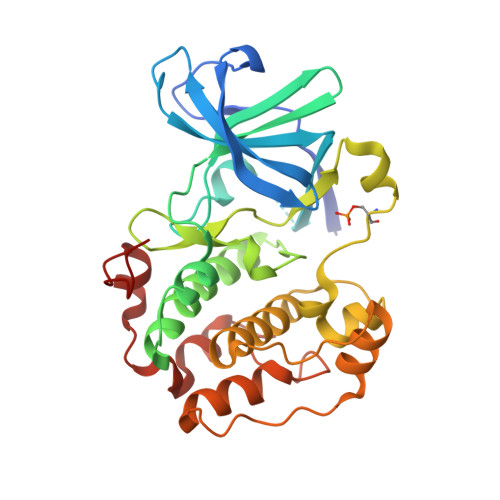Repurposed floxacins targeting RSK4 prevent chemoresistance and metastasis in lung and bladder cancer.
Chrysostomou, S., Roy, R., Prischi, F., Thamlikitkul, L., Chapman, K.L., Mufti, U., Peach, R., Ding, L., Hancock, D., Moore, C., Molina-Arcas, M., Mauri, F., Pinato, D.J., Abrahams, J.M., Ottaviani, S., Castellano, L., Giamas, G., Pascoe, J., Moonamale, D., Pirrie, S., Gaunt, C., Billingham, L., Steven, N.M., Cullen, M., Hrouda, D., Winkler, M., Post, J., Cohen, P., Salpeter, S.J., Bar, V., Zundelevich, A., Golan, S., Leibovici, D., Lara, R., Klug, D.R., Yaliraki, S.N., Barahona, M., Wang, Y., Downward, J., Skehel, J.M., Ali, M.M.U., Seckl, M.J., Pardo, O.E.(2021) Sci Transl Med 13
- PubMed: 34261798
- DOI: https://doi.org/10.1126/scitranslmed.aba4627
- Primary Citation of Related Structures:
6G76, 6G77, 6G78 - PubMed Abstract:
Lung and bladder cancers are mostly incurable because of the early development of drug resistance and metastatic dissemination. Hence, improved therapies that tackle these two processes are urgently needed to improve clinical outcome. We have identified RSK4 as a promoter of drug resistance and metastasis in lung and bladder cancer cells. Silencing this kinase, through either RNA interference or CRISPR, sensitized tumor cells to chemotherapy and hindered metastasis in vitro and in vivo in a tail vein injection model. Drug screening revealed several floxacin antibiotics as potent RSK4 activation inhibitors, and trovafloxacin reproduced all effects of RSK4 silencing in vitro and in/ex vivo using lung cancer xenograft and genetically engineered mouse models and bladder tumor explants. Through x-ray structure determination and Markov transient and Deuterium exchange analyses, we identified the allosteric binding site and revealed how this compound blocks RSK4 kinase activation through binding to an allosteric site and mimicking a kinase autoinhibitory mechanism involving the RSK4's hydrophobic motif. Last, we show that patients undergoing chemotherapy and adhering to prophylactic levofloxacin in the large placebo-controlled randomized phase 3 SIGNIFICANT trial had significantly increased ( P = 0.048) long-term overall survival times. Hence, we suggest that RSK4 inhibition may represent an effective therapeutic strategy for treating lung and bladder cancer.
Organizational Affiliation:
Division of Cancer, Department of Surgery and Cancer, Imperial College London, London SW7 2AZ, UK.

















